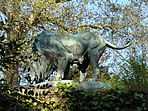Henri Alfred Jacquemart
_French_sculptor.jpg)
Henri Alfred Marie Jacquemart (French pronunciation: [ɑ̃ʁi alfʁɛd maʁi ʒakmaʁ]) (24 February 1824, Paris - 4 January 1896, Paris),[1][2] often known as Alfred Jacquemart, was a noted French sculptor and animalier. He usually signed his works: A. Jacquemart.
Jacquemart studied under painter Paul Delaroche and sculptor Jean Baptiste Jules Klagmann.[3] He entered the École des Beaux-Arts in 1845.
Jacquemart exhibited at the Paris Salon from 1847–1879, receiving medals in 1857, 1863 and 1865. He traveled in Egypt and Turkey, and was commissioned by the city of Alexandria, Egypt, to create a colossal statue of Muhammad Ali of Egypt.
He sculpted in large, medium and small scale. Many of his works were cast in bronze by the Val d' Osne foundry and some by the silversmith Christofle.[4] Ultimately, however, he earned his reputation for his many larger animal works. In 1870 Jacquemart became a Chevalier of the Légion d'honneur.
Jacquemart died suddenly at his apartment in the Rue de Babylone, Paris on the night of 4 January 1896.[5] His funeral was delayed until 13 January for the arrival of his son, Maurice, who lived in Tunis and was held at the Eglise Saint Thomas d'Aquin, Paris.[6][7]
Selected works
- Sphinxes (four), La Fontaine du Palmier, Paris, 1858
- Chimera (two), La Fontaine Saint-Michel, Paris, c.1860
- Evangelists (four), Église Saint-Augustin de Paris, 1862
- Valet au chiens (Huntsman and dogs), many castings (see examples below), 1866[8]
- Louis XII on horseback, bas relief Hotel de Ville de Compiegne, 1869[9]
- Viceroy Mohammed Ali, Alexandria, 1872
- Lions (four), originally meant to stand guard by the statue of Mohammed Ali, but fattened and lengthened by two metres and placed at the opposite entrances of Qasr al-Nil Bridge, Cairo, 1873
- Lions (eight), La Fontaine Place Félix Eboué, Paris, 1874
- Soliman Pasha, Cairo, 1874
- Mohammed Laz-oglou Bey, Cairo, 1874-5
- Rhinocéros, Paris, 1878[10]
| Some works of Henri Alfred Marie Jacquemart |
|---|
 Rhinocéros outside the Musee d'Orsay, Paris  Louis XII bas relief, Town Hall, Compiegne |
| Wikimedia Commons has media related to Alfred Jacquemart. |
Notes
- ↑ Benezit, p.11
- ↑ Obituary, Le Figaro, 6 Jan 1896, p.5
- ↑ Benezit, p.11
- ↑ Payne, p.408
- ↑ La Croix, 7 Jan 1896, p.3
- ↑ La Presse, 8 Jan 1896, p.2
- ↑ La Temps, 6 Jan 1896, p.3
- ↑ Examples include:
- Huntsman and dogs at the Royal Botanic Gardens, Sydney, New South Wales, Australia, c.1879
- Huntsman and dogs at the Forest Glade Gardens, Mt Macedon, Victoria, Australia, c.1879.(http://museumvictoria.com.au/about/mv-blog/feb-2012/huntsman-on-the-hill retrieved 19 Jan 2014)
- Hunter and hounds at Beverly Gardens Park, Beverly Hills, California, USA, date unknown. Originally at Château-Thierry, France. It was installed in Beverly Hills, USA in 1925 on Armistice Day to commemorate Mr. Longyear's, a local resident, son who was killed in the Battle of Château-Thierry (1918). The inscribed plaque misspells Jacquemart's name and confuses his birth and death dates. The sculpture was later donated to the City of Beverly Hills and relocated to the park.
- Huntsman and dogs at the Elswout Estate, Overveen, Netherlands.
- ↑ Benezit, p.11
- ↑ Rhinocéros was commissioned for the 1878 Exposition Universelle and placed in the garden of the Palais du Trocadéro. When the Palais was demolished the sculpture was located c.1935 to 1985 at Porte de Saint-Cloud, Paris. In 1986 it was assigned to the Musee d'Orsay, Paris, restored and placed on display in the forecourt. Horswell, p.292; Musee d'Orsay online catalogue, retrieved 21 Jan 2014.
References
- Benezit, Emmanuel (c.1976). Dictionnnaire de peintres, sculpteurs, dessinateurs et graveurs, 6 JAC-LOY, Paris: Grund
- Cairo Statues
- Horswell, Jane (1971). Bronze sculpture of Les Animaliers, references and price guide, Clopton, England: Antique Collectors' Club
- Insecula entry
- Kjellberg, Pierre (1994). Bronzes of the 19th Century: dictionary of sculptors, Atglen, USA: Schiffer
- Lami, Stanaslas (1914). Dictionnaire de Sculpteurs de l'ecole Francaise, Paris: E. Champion
- Mackay, James (1973). The animaliers; the animal sculptors of the 19th and 20th centuries, London: Ward Lock
- Payne, Christopher (1986). Animals in Bronze: reference and price guide, Clopton, England: Antique Collectors' Club
- Savage, George (1968). A Concise History of Bronzes, New York: Praeger
|

